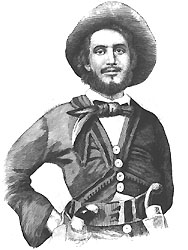By Leon Worden
"Colonel Beale and about fourteen camels stalked into town last Friday — Los Angeles Star, Jan. 27, 1858
Wednesday, April 24, 2002
and gave our streets quite an Oriental aspect."
eale's Cut is the subject of the SCV Historical Society's 1999 calendar. (Available now at the Saugus Train Station in Heritage Junction for a low-low $4.50. Hurry while supplies last. Open Saturday and Sunday from 1 to 4.)
B
No, there aren't 12 different pictures of the big gash through the mountain pass that formed the only practical entry way into this valley until 1910.
For instance, for the month of April, there's an old woodcut of some prospectors leading a team of camels.
What do camels have to do with the SCV? I'll tell you.
To a fairly young United States in the 1840s, everything west of Texas was basically wilderness. President James K. Polk dispatched rugged individuals like John C. Fremont and Kit Carson to pursue the nation's manifest destiny and, ultimately, wrest control of California from the fledgling Mexican government.

Hardships along the way were many. Transporting supplies to Army posts was nearly impossible on the backs of horses and mules that could not travel many miles without water. Jefferson Davis, secretary of war, was sold on the notion that the peculiar beasts of the Arabian deserts would be perfect for the task.
After much debate, Congress gave Davis $30,000 to bring camels to Texas and establish the United States Camel Corps.
The Supply left New York harbor on June 3, 1855, bound for Tunis. With war in the Crimea, the scouts had little luck finding healthy camels not already in use and pushed on through Malta, Greece and Turkey, eventually landing in Egypt. Along the way they learned that the one-humped Arabian camels, native to the Middle East, were best for riding, while the two-humped Bactrians of Asia were best for carrying loads.
Exporting camels from Egypt was forbidden, but the Army officers managed to pay the right people and left for home with five camel jockeys and a herd of 33 camels.
The trip was rough. The beasts had to be lashed down during storms. Nonetheless, the Supply arrived in Indianola, Texas, on April 29, 1856, with 34 camels. Apparently the trip didn't unnerve the beasts all that much.
Able to carry about four times the load a mule could carry, and with about four times the stamina, the Egyptian pack animals hauled supplies to an Army post outside San Antonio.
But that's about as far as the experiment went. Their smell spooked horses, and by some accounts, an influential officer believed the beasts held a grudge against some of his men and lay in wait to spit at them.
In June 1857, Edward Fitzgerald Beale, veteran of the Mexican-American War in California a decade earlier and now an Army colonel, convinced Secretary of War Davis to let him take a herd of camels west.
Beale set out with 25 camels, 44 soldiers and two Arabian drovers — "Greek" George Allen and Hadji Ali, whose name was anglicized by the soldiers to "Hi Jolly." Once they grew accustomed to the trip, the camels proved far superior to mules and horses along the desolate stretch from El Paso to the Colorado River and on through Los Angeles (and Newhall, which wasn't Newhall yet) to the Army base at Fort Tejon at the top of Grapevine Pass.
With Civil War in the air, the U.S. Camel Corps was forgotten by official Washington and by the Confederate forces in charge in Texas — but not by Beale, now Surveyor General of California and Nevada.
Beale continued to use the beasts to haul supplies from Los Angeles to Fort Tejon by way of the road through the Santa Susana Mountains south of present-day Newhall, which the troops improved in 1862 and 1863 (thus, "Beale's Cut").
The Army sold Beale's camels in November 1863. Some went to zoos and circuses, others to mining companies, and several to Beale, who let them roam freely throughout his massive, 300,000-acre ranch. In 1865, the remaining camels in Texas were sold or set free in the desert.
Bactrians wandered to Nevada and Idaho, Arabians to Arizona and California. For years camel sightings were rumored in the Tehachapis and along the banks of the Santa Clara River.
According to the late SCV historian Jerry Reynolds, "The final, sad act of the drama occurred on Dec. 16, 1903 when 75-year-old Hi Jolly was sitting in a saloon at Quartzite, Ariz. A prospector stumbled in, telling of a huge, red camel wandering nearby. Jolly rushed outside and was never seen alive again. According to local legend, his withered body was found weeks later in the remote desert. There he lay with lifeless arms wrapped around the neck of the last camel in the West."
SEE HI JOLLY'S TOMB
©2004 LEON WORDEN — ALL RIGHTS RESERVED

